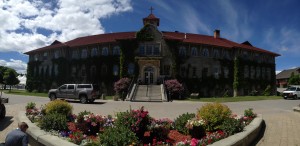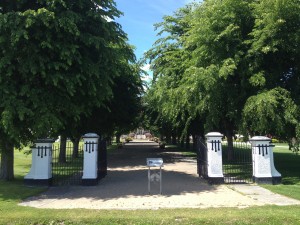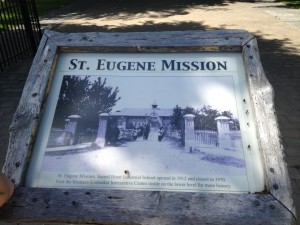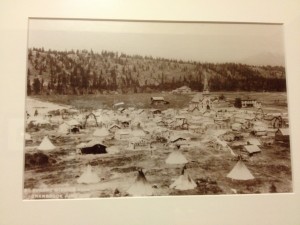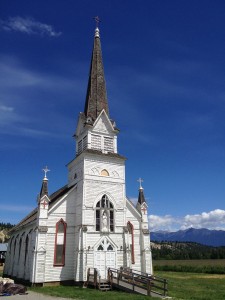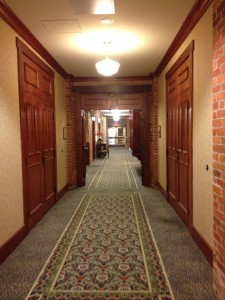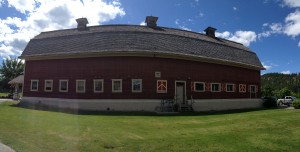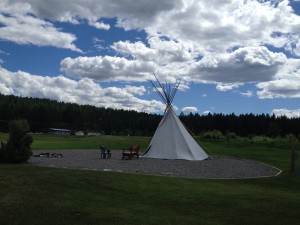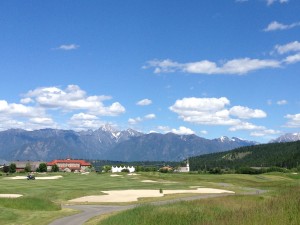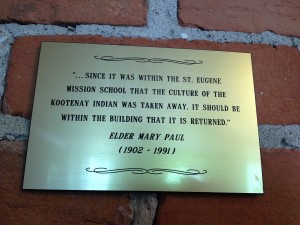A highlight from this week, was an educational experience we sought out – we contacted a gentleman named Gordie for a tour at St. Eugene, a residential school just outside of Cranbrook, B.C.
Gordie was a student back in the late 1950s at St. Eugene, and was one of the active members of the St. Mary’s First Nations Band (along with band members of the other 4 bands in the area) to transform the abandoned St. Eugene into a resort, golf course, and casino. The school was opened in 1912, and closed in 1970 – we were fortunate enough to spend close to 3 hours with Gordie, re-telling his experiences and those experiences of his friends and colleagues.
At the beginning of the tour, Gordie showed us this photograph – showing that First Nations people had clearly settled in the area before missionaries began constructing the school (the church was built in 1897). It was a really great way to help us visualize the space as it was as pioneers began settling in historically, First Nations lands.
The church is also still standing today…
We continued to walk down the hallways and Gordie explained to us how they had altered the building during the restoration process (he was a key member in this undertaking). Many of the old dormitories, used to hold 40 students – are now split into 2 rooms… to hold 1-2 adults per room…
Throughout the tour, he told us stories from when he was a student at the school; how a Father had pushed him down the stairs when he was in Grade 1, or how when he first came to the school, a Father had a line of “Indian-kids” take turns beating him (because he was half First Nations, half European). Along with the heart breaking stories, Gordie also told us of daring feats he had accomplished while at the school; him and a few boys would often scale the walls of the school and sneak into a Father’s room through the balcony and try to sneak over him and out the door without being caught! All things that Gordie said were to keep them from going crazy, being cooped up at the residential school 10-months a year.
Gordie also acknowledged that while one particular Father attended the school while he was in Grade 1 through 4 before moving onto another residential school; that he [Gordie] has “blanked out” much of that time of his life because he thinks it must’ve been too difficult to deal with. However, from Grade 4 onwards – he remembers much of what went on at the school. Gordie was passionate about letting us know that not all experiences at residential school were negative, that sometimes they were quite positive; providing First Nations students with the opportunity to learn academics and pursue other careers. But, he also acknowledges that he was at residential school towards the end, when the stories about abuse and neglect had been surfacing – so he attributes that to not having such “negative” experiences at school.
We were fortunate enough to tour the barn, next to the school, that once housed a massive swimming pool that the children were able to swim in…
There was also a teepee and circle set-up outside the back of the school where First Nations people were welcome to spend time with their families and friends to celebrate, or to console one another after re-living traumatic experiences…
Gordie also managed to get a hold of a golf cart and drive us around the course where he pointed out the spring that they would need to collect water from and carry it back to the school, as well as the cemetery that was located right beside the school grounds.
This tour, and opportunity we had to speak with an individual who had lived through the residential school experience was truly invaluable. It is one thing to hear stories from films, conferences, seminars, or to read it in essays and books; but to speak with an individual and have the opportunity to have discussions and ask questions was something to be thankful for. Now I feel that I have a better understanding of the residential school system, and can actually put stories and accounts into a context and a setting.
One question that we did ask Gordie, was why did they want to do something with the school and the land? Why not just tear it down? Gordie responded with a quote from one of the 5 First Nations Band leaders…

